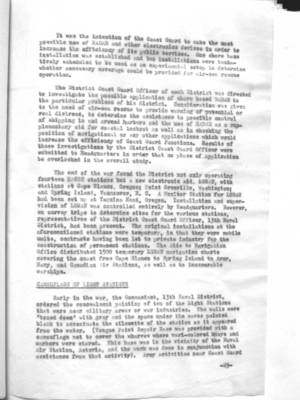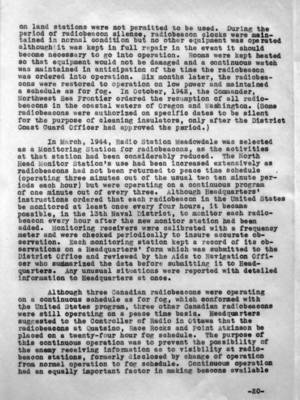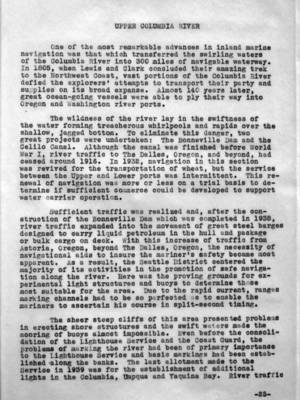Pages That Mention Washington
Coast Guard District narrative histories 1945
12
It was the intention of the Coast Guard to make the most possible use of RADAR and other electronics devices in order to increase the efficiency of its public services. One shore base installation was established and two installations were tentatively scheduled to be used as an experimental setup to determine whether necessary coverage could be provided for air-sea rescue operation.
The District Coast Guard Officer of each District was directed to investigate the possible application of shore based RADAR to the particular problems of his district. Consideration was given to the need of air-sea rescue to provide warning of potential or real distress, to determine the assistance to possible control of shipping in and around harbors and the use of RADAR as a supplementary aid for coastal lookout as well as in checking the position of navigational or any other applications which would increase the efficiency of Coast Guard functions. Results of these investigations by the District Coast Guard Officer were submitted to Headquarters in order that no phase of application be overlooked in the overall study.
The end of the war found the District not only operating fourteen RACON stations but a new electronic aid, LORAN, with stations at Cape Blanco, Oregon; Point Grenville, Washington; and Spring Island, Vancouver, B. C. A Monitor Station for LORAN had been set up at Yaquina Head, Oregon. Installation and supervision of LORAN was controlled entirely by Headquarters. However, on survey trips to determine sites for the various stations, representatives of the District Coast Guard Officer, 13th Naval District, had been present. The original installations at the aforementioned stations were temporary, in that they were mobile units, contracts having been let to private industry for the construction of permanent stations. The Aids to Navigation Office distributed 1500 temporary LORAN navigation charts covering the coast from Cape Blanco to Spring Island to Army, Navy, and Canadian Air Stations, as well as to innumerable warships.
CAMOUFLAGE OF LIGHT STATIONS
Early in the war, the Commandant, 13th Naval District, ordered the concealment of painting of ten of the Light Stations that were near military areas or war industries. The walls were "toned down" with gray and the space under the eaves painted black to accentuate the silouette of the station as it appeared from the water. (Tongue Point Repair Base was provided with a camouflage net to cover the wharves where vari-colored buoys and markers were stored. This base was in the vicinity of the Naval Air Station, Astoris, and the work was done in conjunction with assistance from that activity). Army activities near Coast Guard
-29-
18
Superintendent of the former Lighthouse Districts became assistants to the District Commanders of the new Coast Guard Districts for the administration and operation of Lighthouse functions. Since, in many cases the Office of the District Commander and that of the Lighthouse Superintendent were in different localities, problems of both administration and operation resulted. As a result, whenever possible, these administrative offices were combined. It was desired to increase efficiency through coordinated use of personnel, vessels, boats, shops and supplies and economy in operation through a reallocation of facilities to avoid duplication.
327 Lighthouse Service personnel were employed in the Seattle District at the time of the consolidation. This was a far cry from the handful of men who beat their way through the wilderness in 1849 to find a site for a lighthouse on the desolate shores of the Northwest Pacific. At that time, Congress had allotted $15,000 for the establishment of two lighthouses and 12 can buoys at the entrance to the Columbia River. This began the activities of the Lighthouse Service in the 13th Lighthouse District which included Oregon and Washington and later Alaska. The boundaries of the Lighthouse Districts followed closely those of the Coast Guard Districts.
39
on land stations were not permitted to be used. During the period of radiobeacon silence, radiobeacon clocks were maintained in normal condition but no other equipment was operated although it was kept in in full repair in the event it should become necessary to go into operation. Rooms were kept heated so that equipment would not be damaged and a continuous watch was maintained in anticipation of the time the radiobeacon was ordered into operation. Six months later, the radiobeacons were restored to operation on low power and maintained a schedule as for fog. In October, 1942, the Commander, Northwest Sea Frontier ordered the resumption of all radiobeacons in the coastal waters of Oregon and Washington. (Some radiobeacons were authorized on specific dates to be silent for the purpose of cleaning insulators, only after the District Coast Guard Officer had approved the period.)
In March, 1944, Radio Station Meadowdale was selected as a Monitoring Station for radiobeacons, as the activities at that station had been considerably reduced. The North Head Monitor Station's use had been increased extensively as radiobeacons had not been returned to peace time schedule (operating three minutes out of the usual two ten minute periods each hour) but were operating on a continuous program of one minute out of every three. Although Headquarters' instructions ordered that each radiobeacon in the United States be monitored at least once every four hours, it became possible, in the 13th Navel District, to monitor each radiobeacon every hour after the new monitor station had been added. Monitoring receivers were calibrated with a frequency meter and were checked periodically to insure accurate observation. Each monitoring station kept a record of its observations on a Headquarters' form which was submitted to the District Office and reviewed by the Aids to Navigation Officer who summarized the data before submitting it to Headquarters. Any unusual situations were reproted with detailed information to Headquarters at once.
Although three Canadian radiobeacons were operating on a continuous schedule as for fog, which conformed with the United States program, three other Canadian radiobeacons were still operating on a peace time basis. Headquarters suggested to the Controller of Radio in Ottawa that the radiobeacons at Quatsino, Race Rocks and Point Atkinson be placed on a twenty-four hour fog schedule. the purpose of this continuous operation was to prevent the possibility of the enemy receiving information as to visibility at radiobeacon stations, formerly disclosed by change of operation from normal operation to fog schedule. Continuous operation had an equally important factor in making beacons available
-20-
44
One of the most remarkable advances in inland marine navigation was that which tranferred the swirling waters of the Columbia river into 300 miles of navigable waterway. In 1805, when Lewis and Clark concluded their amazing trek to the Northwest Coast, vast portions of the Columbia River defied the explorers' attempts to transport their party and supplies on its broad expanse. Almost 140 years later, great ocean-going vessels were able to ply their way into Oregon and Washington river ports.
The wildness of the river lay in the swiftness of the water forming treacherous whirlpools and rapids over the shallow, jagged bottom. To eliminate this danger, two great projects were undertaken: The Bonneville Dam and the Celilo Canal. Although the canal was finished before World War I, river traffic to The Dalles, Oregon, and beyond, had ceased around 1916. In 1932, navigation in this section was revived for the transportation of wheat, but the service between the Upper and Lower ports was intermittent. This renewal of navigation was more or less on a trial basis to determine if sufficient commerce could be developed to support water carrier operation.
Sufficient traffic was realized and, after the construction of the Bonneville Dam which was completed in 1938, river traffic expanded into the movement of great steel barges designed to carry liquid petroleum in the hull and package or bulk cargo on deck. With this increase of traffic from Astoria, Oregon, beyond The Dalles, Oregon, the necessity of navigational aids to insure the mariner's safety became most apparent. As a result, the Seattle District centered the majority of its activities in the promotion of safe navigation along the river. Here was the proving grounds for experimental light structures and buoys to determine those most suitable for the area. Due to the rapid current, ranges marking channels had to be so perfected as to enable the mariners to ascertain his course in split-second timing.
The sheer steep cliffs of this area presented problems in erecting shore structures and the swift waters made the mooring of buoys almost impossible. Even before the consolidation of the Lighthouse Service and the Coast Guard, the problems of marking the river had been of primary importance to the Lighthouse Service and basic markings had been established along the banks. The last allotment made to the Service in 1939 was for the establishment of additional lights in the Columbia, Umpqua and Yaquina Bay. River traffic
-25-
46
actuality except for the initial voyage of such a vessel to The Dalles, Oregon, in 1939 to prove the channel was large enough for traffic of this type. A conference with marine interests was held in 1943 and a program for proposed aids between Vancouver, Washington and Bonneville was drawn up. The necessity for additional aids was intensified by the continual requests from government agencies to increase the total tonnage on the Columbia River because, due to the manpower shortage, inexperienced men were operating vessels over these treacherous waters and also because almost all railroad tank cars had been taken out of the area due to the war emergency. This placed an exceedingly large burden on the water carriers to transport the required petroleum products for the Army and Navy Air Forces on the Columbia River. The area was marked, at that time, by 6 ranges, 26 lights and 2 beacons.
The new program presented to Headquarters in 1945 requested that 51 structures be electrified and that duplex lanterns be replaced by single General Railway signal, Type "SA" lanterns in order to simplify and standardize equipment. This proposed project was approved by Headquarters and work began instantly. The contour of the shore in this area, near Multnomah Falls, created precipitous cliffs rising almost from the water's edge which prevented the use of the customary range, and, consequently, it was proposed to install experimental channel limiting group lights which had been temporarily established at Arlington beyond The Dalles, Oregon. (See Arlington Channel Limiting Group Lights under "Experimental Range Markings".) Headquarters disapproved the use of the new ranges and as a result, the area was left inadequately marked as the conventional two board ranges could not be established on the sheer banks. (A great number of the rear lights of conventional ranges installed above Celilo were fixed instead of flashing. When the lights were first installed, both front and rear lights were flashing. As this section of the river was very dangerous due to the rocks and whirlpools and side currents, the operators of the boats had very little time for observation of ranges which were astern when going up the rapids as the current and the whirlpools were continually changing the boat's course. If the light was at an eclipsed state when the operator looked back at the range, he was unable to determine whether or not he was on the course as very little time could be spent looking for the range.)
-27-




